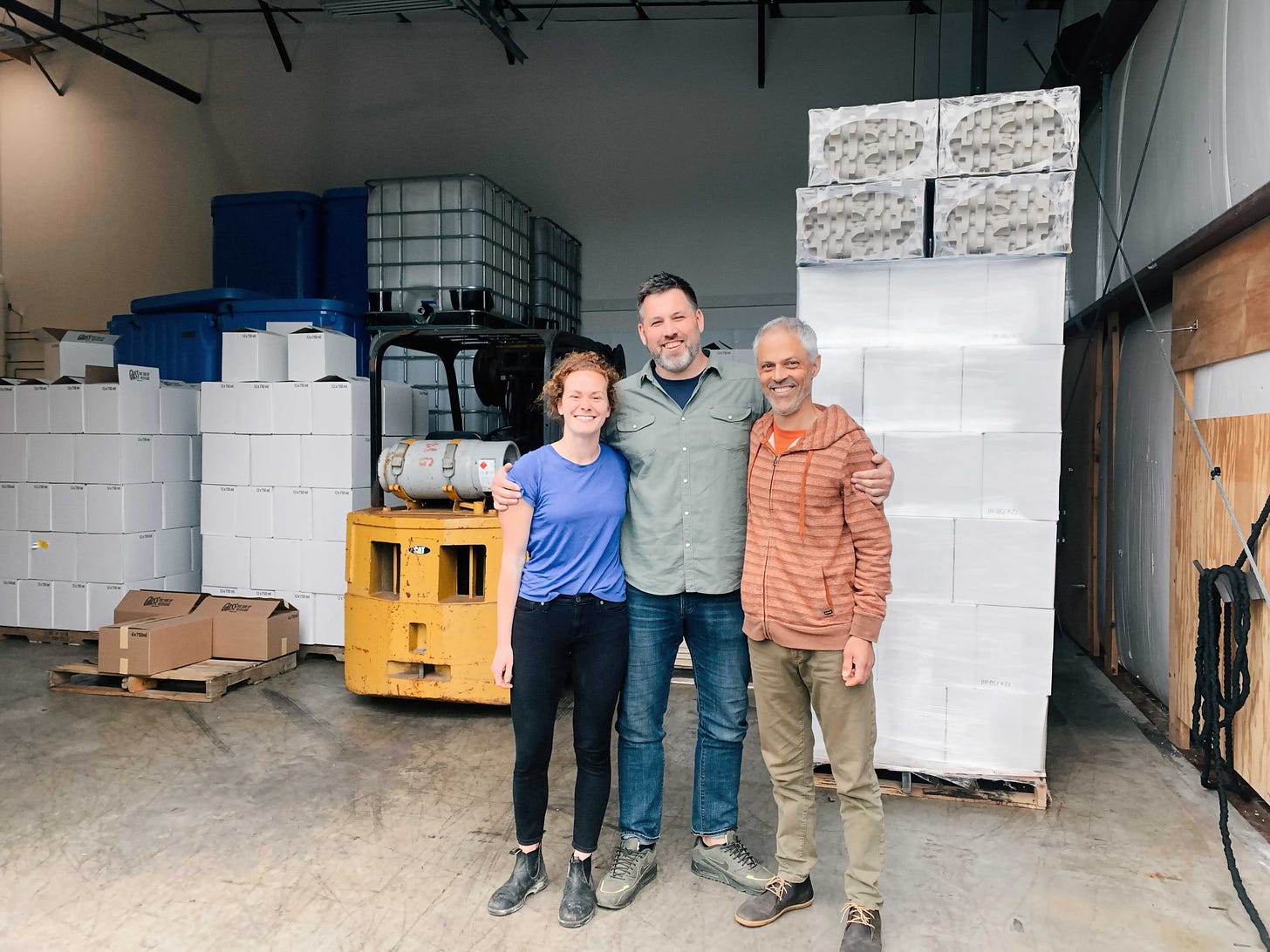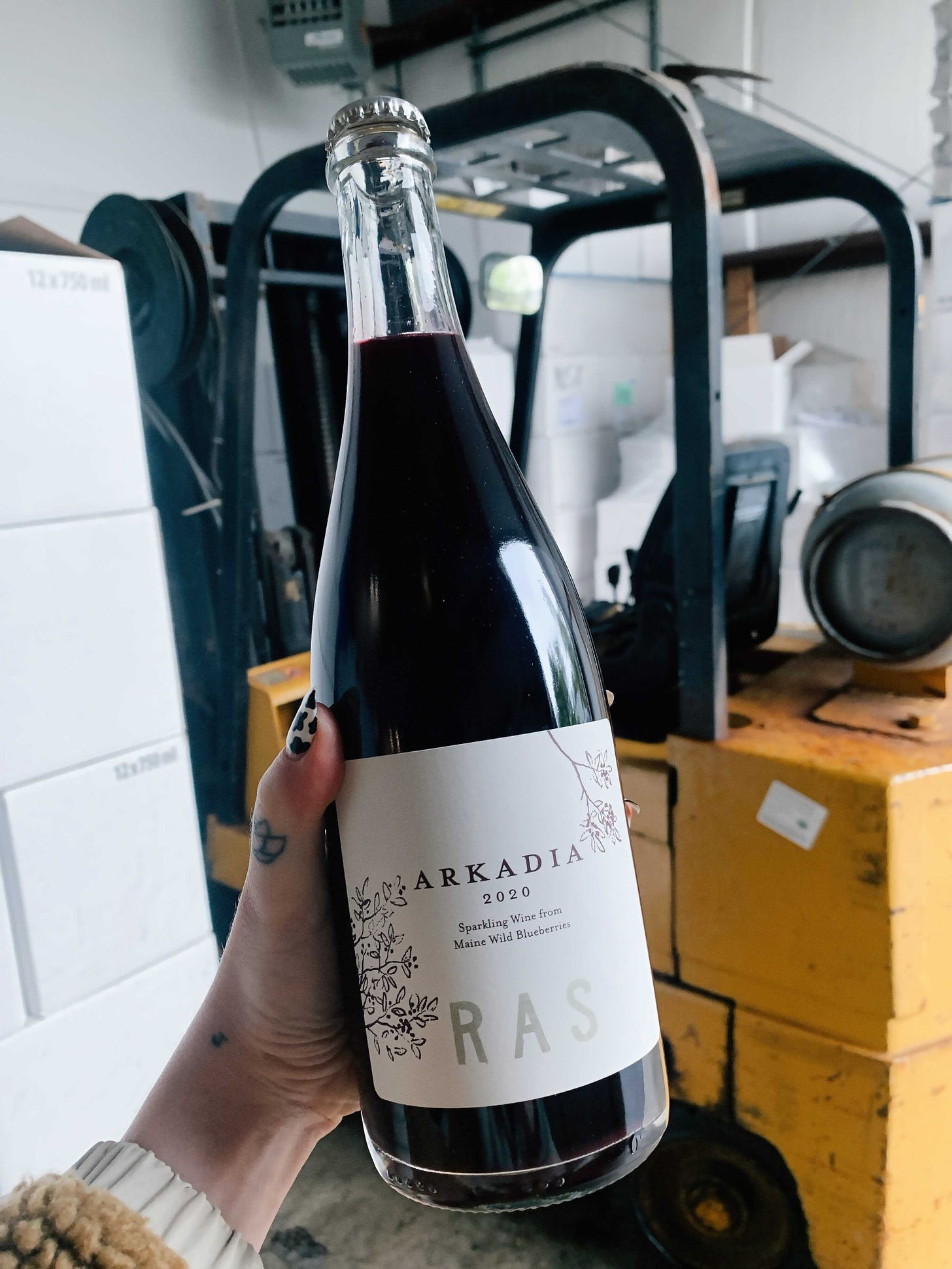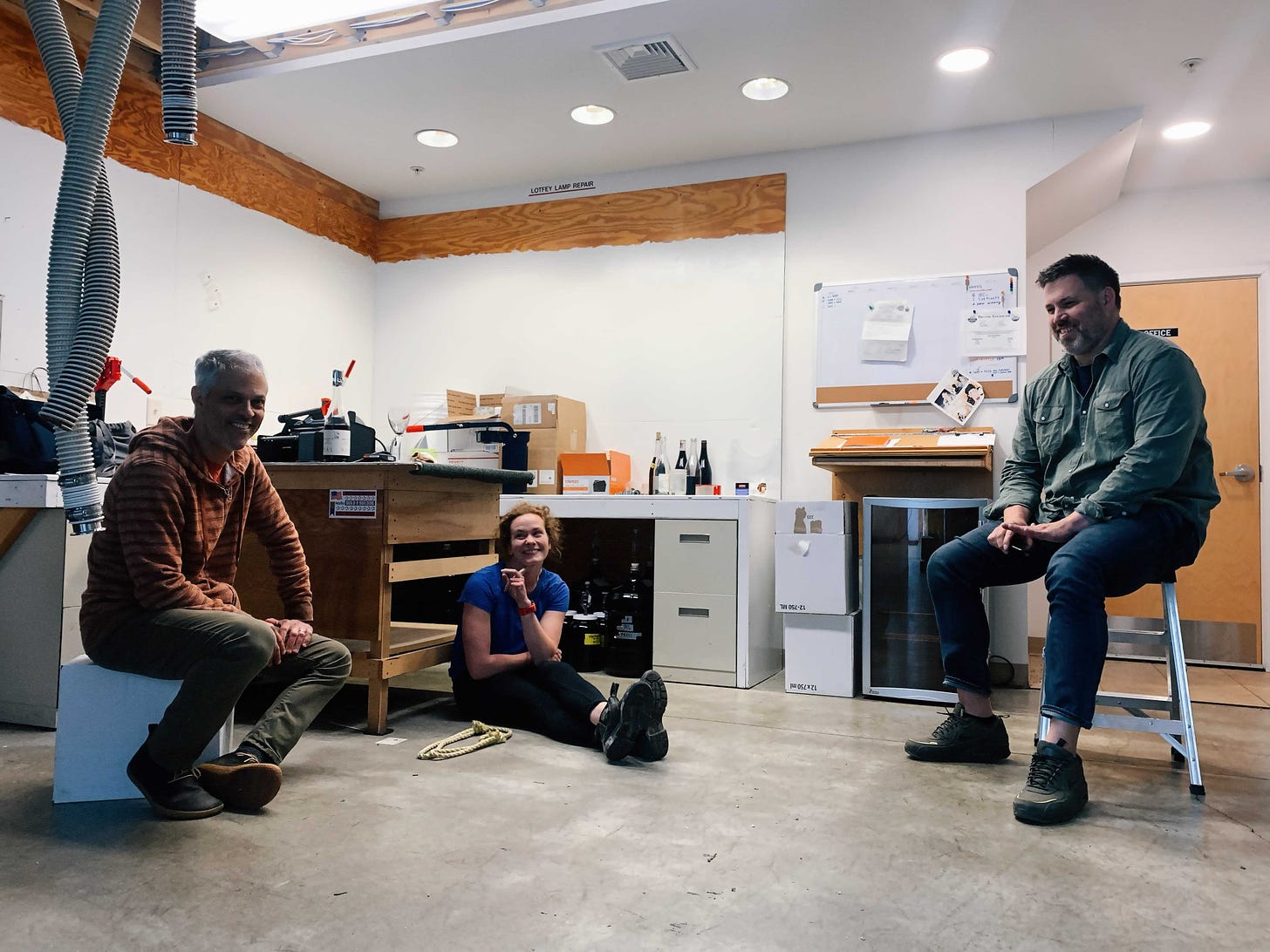The Fizz #23: R A S Wines is building a blueberry wine industry in Maine from the ground up.
I spoke to winemakers Emily, Dan, and Joe about their wild blueberry wine project, getting a winery off the ground, and their hopes for the future of the Maine fruit wine industry.
It’s an exciting time for the Maine wild blueberry wine industry. For this issue, I drove up to Portland, Maine to meet the three passionate winemakers behind R A S Wines, a winery focused on making Maine’s wild blueberries the star. The United States has quite a history with fruit wines, and although blueberry wine has been mainly on the at-home hobbyist side of things, several wineries, including R A S, Oyster River, and Bluet have been giving the fruit the commercial and national attention it deserves.
The R A S facility is a small one, just over 1000 square feet of usable space, which they make the most of. Emily Smith, Joe Appel, and Dan Roche are the three winemakers, sharing winemaking responsibilities and other business roles, with Emily heading up marketing, Joe mostly responsible for the sales side of things, and Dan focused on business development and operations. These folks don’t have a winemaking history. They didn’t go to the famed U.C. Davis for enology or come from winemaking families. They fell in love with wine, saw an opportunity to shine a light on their home state and to support the community they call home.
The three of them met working at Portland’s Rosemont Market and Bakery, a grocery store committed to supporting local farmers and makers (there are now six stores in Greater Portland). Joe was their first hire in 2005, Dan came on in 2007, and Emily in 2011. They bonded over food and wine, learned about local food producers, and came together around the Maine food and beverage community. After meeting the folks at Bluet, they realized an opportunity to bring their local Maine product—wild blueberries—and their newfound passion for wine together into a fruit wine project.
R A S is a brand new winery just finding their footing—they released their first vintage of their first wine, Arkadia in 2021. For this interview, we sat on the floor of their winery and talked for two hours about the past, present, and future of R A S.
Margot: Take me back to before R A S—how did you all come together?
Joe: Dan and I started working in the kitchen at Rosemont. Like so many fortuitous things, if the kitchen had been larger, Dan and I maybe wouldn’t have become as close friends.
Dan: We were fortunate enough to be invited with the store manager to taste wines as distributors came with their suitcases full of wine. That’s how we were introduced to wine. That evolved for us where we eventually became retail buyers and sellers of wine at Rosemont. Emily was Head of Marketing. It allowed us to do some amazing travel and meet amazing people. We truly just fell in love with wine. When our time at Rosemont was done in 2019, we got together and thought okay what are we going to do now?
Margot: Why did you choose to make wine in Maine?
Emily: We never talked about doing it anywhere other than Maine. We wanted to make something that expresses this place. At that time, we had conversations with the Bluet folks, who are very excited about creating a wild blueberry wine industry. We thought maybe this is a sign—right place, right time. We just jumped in.
Dan: Not only did Rosemont help create this love of wine, but it helped us fall in love with Maine. We became good friends with farmers, producers, people doing awesome things and growing excellent products in our community. The amount of support for people from here making things, it’s very inclusive. I never considered moving and making wine somewhere else.
Emily: Working with wild blueberries gives us an opportunity to be a part of the Maine economy of growers, and we can put our support financially behind creating a value added product that will keep Maine healthy economically. That community of small and medium sized farms is really important, and we can help people who live this way, whose livelihood depends on people buying this fruit. It felt like the right path.
Margot: How did you find your growers?
Joe: We work with a family called the Nashes, in Appleton Maine, Midcoast area, and the Beal family in Whiting, a small town DownEast, and we’ll start with an additional grower, Blue Barrens Farm, also in the Midcoast area, this summer. Because we are only working with certified organic fruit, that constrains us to a certain degree. We need organic, and we need volume. A lot of the 100% organic growers are very very small. If we were to buy elsewhere, we’d need to be buying from 23 organic growers, mostly selling quarts at farm stands. Lily Calderwood, the Assistant Professor of Horticulture at University of Maine at Orono works with the University of Maine Cooperative Extension, and she was great early on—we reached out and she gave us a list of growers to call.
Margot: There’s a history of indigenous folks in Maine growing blueberries, especially up North. Do you work with any of those growers at all?
Joe: Right now, no. I asked Lily specifically about that, and she said she couldn’t quite find organic practices up there from indigenous growers.
Emily: Starting out, we’re trying to build a business and differentiate ourselves, and the organic certification helps a lot there. I don’t care about the certification as much as I care about practice. It’s a push-pull. We’re still figuring things out, but moving forward, the most important thing will be supporting as many folks as we can, and focusing on sustainable practices rather than certified organic practices.
Margot: Do you find that the certification on the wine label is helpful for consumers?
Emily: We hope so!
Dan: We don’t really know. We try to talk about it, but maybe people aren’t as interested in that. When we got our sulfite waiver, I was super psyched about that, but I haven’t seen it on any shelf talkers, and I haven’t really heard people talking about it. [Because they add no sulfites, the wine tested at less than 10ppm and so they were able to label the wine itself (not just the fruit used) as “organic”. A sulfite waiver means they don’t have to add “contains sulfites” to their bottles.]
Emily: You’re sort of sitting in on a team meeting now, but I think the sort of people interested in the wine we’re making maybe would like it more if we were helping as many growers as we can. We wanted to make it attractive and appealing to people and differentiate it as well.
Joe: We’re putting this thing out into the world, but we can no longer have the final conversation with the customer—it’s in stores, on wine lists. That certification takes away a bit of that effort. The fact is, we want growers we trust to lead the way. We support and respect our growers who went through the trouble to get certified organic, but we overall just want to follow the lead of growers who are working sustainably, some of whom might not want to put up with all the bureaucracy of certification. And so if someone doesn’t get certified but is working sustainably, we want to support that, too.
Margot: That makes sense—that certification might help as you start out in the market, and maybe you can start to branch out to more growers over time. How do you see yourself giving back to the Maine grower community?
Emily: The payment structure for wild blueberry farmers is rigged against them. The processors are the buyers, and they set the price for blueberries after they’ve been harvested and delivered. They get back to them in December with the price—it gets adjusted to make sure that the processor makes a profit, and that gets passed down to the grower. The processor tells the grower how much they’ll pay for the fruit. You can imagine being a kid of a blueberry grower—that doesn’t seem like a great career path. It’s financially hard, there’s no guarantees, and you’re dealing with the weather difficulties.
As a business, we’re just trying to get off the ground, but I want to set our own price that’s much higher for these growers. This year we’ve shown we can sell this wine, and now let’s build into our margin a higher price point for these growers, so they want to work with us, and so they can make a living. If you can get enough people to sign on to paying that price, that can make an impact for these people.
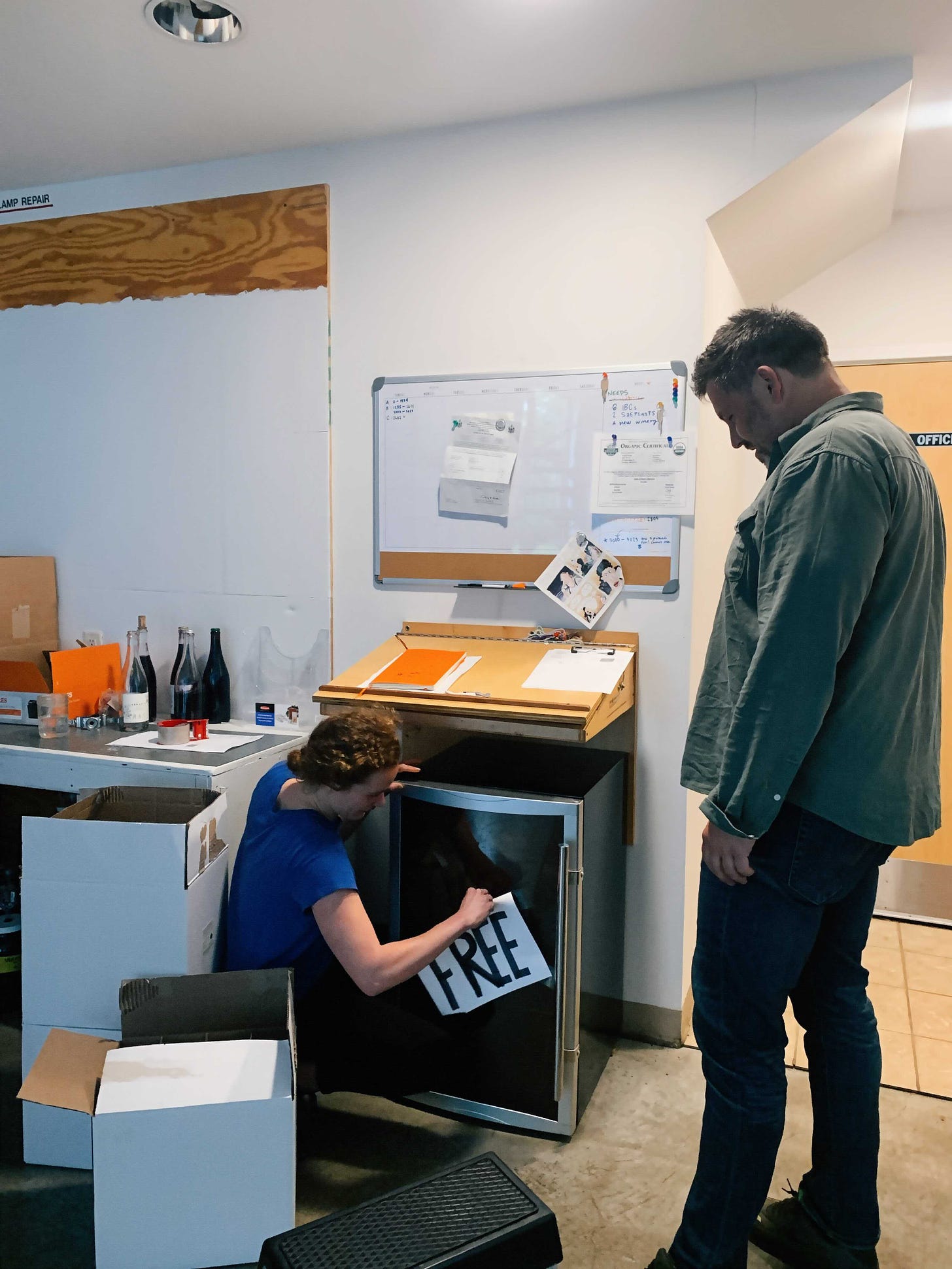
Margot: That would depend on the fruit wine industry growing here in Maine?
Emily: Yes, and on us growing. This year we plan on doubling our production. The demand is there from customers to buy our wine at the price we set, and we can adjust that price to allow us to pay more to our growers.
Margot: How much do you pay them?
Joe: Last harvest, we paid our two growers different prices, and the growers actually billed us. They waited to get the price set by the processor, and sent us a bill. 99% of all Maine wild blueberries get frozen. That’s what the processor does. They get back to the grower and say okay 2020, that’s the price, and the grower passed that same price on to us. That’s around $1.30 per pound. I think because that’s the reality they’ve been living with for so long, there was no question to them, they just pass on that same price.
Emily: I naively came into this thinking these growers need a market for their blueberries, and just by entering this business we can be helpful. They don’t need us at all, though—they’ll sell the fruit to the processor. We have to pay them more, whatever we can afford to. I don’t want to pay the lowest possible price.
Joe: There’s a history of growers coming together and demanding a certain price—last time they tried to do it, there was a really great harvest, and they said well we have more yield so let’s drop it. Wild blueberry growers were modeling it after potato growers, who would tell their processors we can guarantee you X yield if you guarantee us Y price, but wild blueberry growers cant guarantee that reliability, so they don’t have as much leverage.
Margot: It’s great to hear that you’re focusing on paying growers more as you grow your business, and thank you for that transparency! Can you tell me a bit more about your fermentation process?
Joe: We oriented toward wine the same way we oriented toward farmers back at Rosemont. When it came to making wine—there are all sorts of ways to be a winemaker. You can enzyme it to hell, add chemicals, do all this stuff. We don’t eat that way and we don’t want to be a part of that. It informed our way of making wine.
We wanted to try using natural yeast, as long as there wasn’t a risk that we were going to lose all the fruit. When we were in retail, we weren’t native yeast fermentation die-on-the-sword people. There were certainly wines we sold who inoculated. But we just wanted to try it and go for it. Everyone talks about yeast growing on grapes, in cellars, in vineyards, but no one has talked about it in wild blueberries before. We were mostly like—can we do this?
Dan: We were nervous for a bit. The fermentation was very slow to start. We kept checking it and checking it. We’d lift the top and smell it and see if we felt any CO2. After ten days we said fuck it, we all, including our kids, jumped in the berries and stomped them. We threw dry ice on the top to protect it, and the next time we checked, it was raging. It took us just getting some oxygen in there and moving it around.
Margot: How is the fruit prepped when it comes in?
Joe: There’s just a light winnowing—that just means some of the leaves are blown off. It’s different with our two different growers. DownEast, they brought the fruit down here, and it came in cleaner—they had a more thorough winnowing process that we paid for. The Midcoast fruit was full on twigs. We just left all of it on the fruit.
Margot: Hey, that’s stem inclusion right there!
Emily: I do think it’s more expressive, with more of a sense of place. There’s a bit more tannin on the end, too. We wanted to make a wine that expresses where it’s from, and there it is.
Margot: Do you separate your fruit by grower?
Dan: Yes, the DownEast fruit came in a month later, and we pressed maybe 75% of the Nash fruit by the time the DownEast fruit came in.
Joe: Everything bottled out here [gestures toward the winery] is from the Nash fruit. The Josh Pond Farm fruit, their fruit was starting to raisin on the bush a bit, and came in way more concentrated with higher sugar. It was later in its ripening cycle than the previous fruit. From the minute those boxes of fruit came in, we realized it was different. We kept it separate and had roughly the same 4 week fermentation duration and pressed it. It went into its own IBC and every time we took off the lid, the CO2 was just so alive. We just bottled it three weeks ago. Once secondary fermentation is complete, if it continues to taste different, it’ll be its own cuvée.
Dan: It’s a single field, and such a unique place. It’s amazing. When you go up that far, it’s a different world. It’s not dissimilar from going on a wine trip in Europe, for example.
Margot: That’s so awesome. I think we personally know that there is terroir in fruit—we know that a tomato from New Jersey tastes different from a California one, for example. We just haven’t really seen that shown in fruit wine yet. Can’t wait to try your site specific wines. How does that secondary fermentation happen?
Dan: We ferment it totally dry. We tried this method, adding a little bit of sugar to activate the yeast present—we didn’t want to add any more yeast because we didn’t want to have to disgorge the wine. It’s a method called Col Fondo, an old school Prosecco style. That’s what we practiced a bunch last winter, and we figured out the amount of time we needed for it to settle, how much sugar is too much, how much would make the wine gush. We settled on a number and that’s how we do it. We add just under 16g/L.
Joe: Primary fermentation completes, we add a bit of sugar. I hope that next time we can try wild blueberry juice or concentrate instead of using sugar. With all the variables we had going on this year, we just used sugar to start. We talked to Champagne producers to see what they thought, even natural producers, and they all said to use sugar.
Margot: What are some of the lessons you learned last year that you’ll take along with you for this year’s fermentation?
Dan: We should have gotten the fermentation going faster. We waited not knowing for ten days, just thinking and hoping. Now that we know what it takes, we’ll get it going much earlier. Monitoring more for acetic is going to be important.
Honestly we went into this thinking, if we make a wine that is even sellable, that’s a win. Tasting it now, it’s so much better than I ever expected. And it can be better, still. This year, I’m even concerned about polishing it up too much to detract from its character.
Emily: When I think of flaws, it’s more of me projecting my insecurities onto the wine. We talk about Arkadia like a rosé where it’s a really young wine, just starting to express itself. We don’t know what it will taste like in a year. We know blueberries age well, and in my mind, the wine is just going to get better and be a wine of longevity. How much should we change? We don’t actually know what it’ll be like—we’ve only just met this wine.
Joe: The frame of reference of talking about wine flaws in grape wine has a lot more to do with oxidation. It’s such a risk with most grapes, whereas with wild blueberries, the antioxidants are so high naturally that it’s hard to imagine oxidation ever being an issue. We’ve had bottles we’ve opened and left out for like two weeks. The bubbles go away, but the wine is proper. We’re not going to get oxidative flaws, or foxiness or mouse, but we’re just starting to make friends with this wine, so we’ll see. The flaw potential is with acetic, and monitoring its possibility of gushing out of the bottle, since there’s no disgorging.

[We tasted the Arkadia together at the winery. It’s blueberry forward—there’s no mistaking that this is a wild blueberry wine. The wine has zip, freshness, while retaining the blueberry fruit. The tannin is light and fine, even though we’re tasting the wine with the most “stem inclusion”—the one that was winnowed less. It’s bright and delicious, and makes me want to sit on a dock on a summer day. I had tasted this wine previously at Portland’s Hunt and Alpine where they let me taste a freshly opened bottle, and one that had been open for three days. The three day old bottle was still absolutely delicious, a bit deeper of a flavor, but still completely fresh and perfectly drinkable. The power of blueberry antioxidants!]
Margot: How did you all fund the start of the winery?
Joe: We got a loan from my family that all three of us are responsible for paying back, and some of each of our personal savings.
Dan: We had to go through his family banking lawyer, and we took the loan as equal partners. There’s this idea that anyone can do this, but the only way we could do it was because we were able to cash in some of our money and take this loan. Just to pay for your first harvest—it was almost two years. It’s a huge expense.
Emily: The financial barrier to entry in this industry is huge. As more people come into this industry, there could be shared spaces and shared equipment, but the industry just isn’t there yet.
Joe: There’s a non-profit we talked to early on called CEI that tries to find funding for food businesses. Theoretically, we could have gotten some loans through them but with real difficulty. It’s not made easy, and for good reason—we’re basically starting a whole new industry with no proof of anything and we need $200k. If you were getting into cannabis now, you’d have a stronger platform to stand on.
Margot: You have a vermouth coming out! Why did you choose to make that?
Emily: We love vermouth! We love the culture around it. I love the idea of adding things to your wine, making something, experimenting with herbs. We first wanted to do just things you can find in a blueberry field. We are still thinking about doing that. There’s so much experimentation to do and vermouth is a whole other thing to play with. We’re a week from bottling it now. We worked with a friend, Nolan Stewart, who helped us find the flavors for the vermouth.
Joe: He does mini infusions and made us many different batches so we could taste and give feedback and figure out the final flavor. We do add some honey, but it won’t be a sweet vermouth, it’ll be more off-dry with some bitter components to it. Most vermouth starts with a pretty neutral wine. We’re starting with a very non-neutral wine. We had to figure out the right ingredients that would work with that blueberry wine. We have orange peel, cinnamon, cardamom, gentian, fennel, and some honey in there right now.
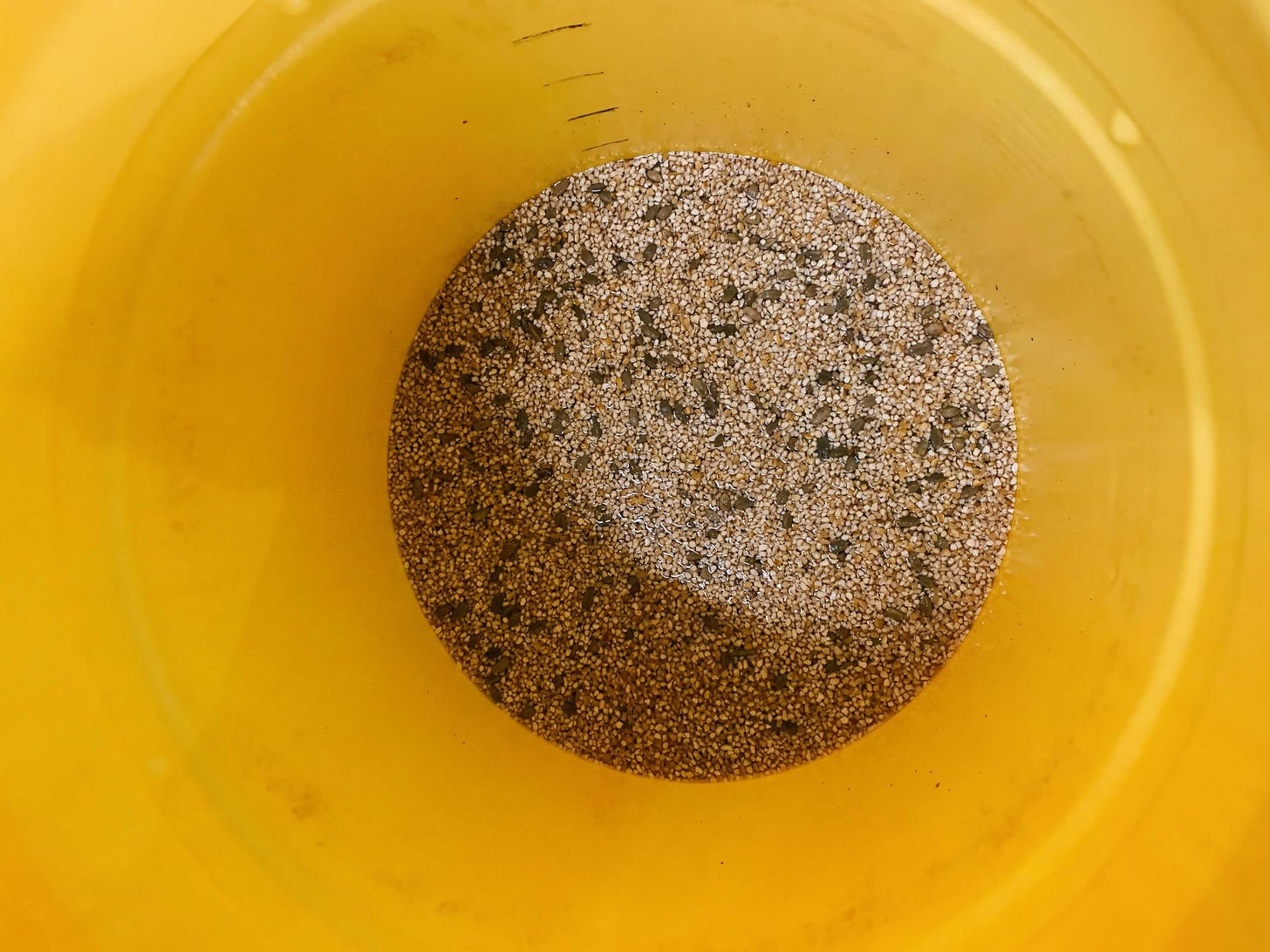
Margot: What are your goals for the future of R A S?
Joe: I’d like to continue making Arkadia, maybe make a wine that is less expensive and more accessible—maybe putting wine in kegs? A lot of fruit has to get tossed when going through the picker for processors, and we’re hoping to buy that fruit that would have been thrown out anyway. That way we can get it for cheaper and sell it for cheaper. I’m really excited to do more site specific wines and highlight the farmers.
Dan: My hope is to make this company successful for us and live lives that are in balance with everything else that’s important to me—family and travel, good food and wine. I’d like to build this so we can work but not overwork ourselves and live a life that is in balance. It’s not about growing to the point of domination or having many different tasting rooms or whatever, it’s about having sustainability for our lives.
Margot: Thanks so much for talking with me and sharing your story. I can’t wait to taste the vermouth, and to support you all along your journey—it’s definitely inspiring!
—————
You can support these inspiring makers by buying their wines, following them on Instagram, and requesting their wines from your local wine shop. Help us grow the wild blueberry wine industry by asking your local shops to stock them!
Local to New England? Catch me moderating a panel with R A S, Bluet, Oyster River, and Ravines for Portland Wine Week on June 14. Buy your tickets here—it’s going to be an excellent conversation around the past, present, and future of American winemaking in the NorthEast.
Liked this interview? Hit subscribe and help me record more information about exciting winemakers, American history, and so much more. Paid subscriptions are just $5/month or $50/year, and 20% goes to St. Francis House. If you share this piece with a friend, it would mean a lot. Thanks for reading! You can follow me on Instagram here, and support my upcoming American wine business here.




